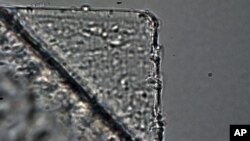A NASA spacecraft dispatched 15 years ago to collect samples from a comet also snared what scientists suspect are the first dust specks from interstellar space.
The Stardust robotic spacecraft was launched in 1999 to fly by a comet and collect samples from Comet Wild 2 and parachute them back to Earth in 2006. Before reaching the comet, the spacecraft also twice opened a collection tray to fish for particles that may have come into the solar system from interstellar space.
Now, after a Herculean effort involving thousands of volunteer researchers, scientists say they have what they believe are the first seven specks of freshly plucked dust hailing from exploded stars and other cosmic phenomena beyond the solar system.
The grains, described in a paper in this week's edition of the journal, Science, are unexpectedly diverse in shape, size and content, indicating that interstellar dust likely has a more complex and varied evolution than originally thought, said lead author Andrew Westphal, a physicist with the University of California Berkeley's Space Science Laboratory.
Two of the particles are bigger than the rest, though that is a very relative term when speaking of specks that are about four microns, or one-16,000th of an inch (0.0004 cm) across.
These two dust grains, which appear fluffy, like snowflakes, contain a magnesium-iron-silicate mineral called olivine, a hint that they may have come from disks around other stars before being altered by interstellar travel, Westphal said.
Some of the interstellar grains also may have organics, added space scientist Michael Zolensky, who oversees NASA's collection of extraterrestrial samples at the Johnson Space Center in Houston.
Scientists hope to tease out more information from the dust motes, but not quite yet. They say more sophisticated equipment and processes are needed to analyze the tiny samples without destroying them.
“The prudent thing is just to put these away for a while and then wait until better techniques come along to make the analysis,” Zolensky said.
In the meantime, the volunteer effort to find other potential interstellar grains in Stardust's collection trays continues. The particles were trapped in a smoke-like substance called aerogel, but their telltale impact tracks are so tiny that scientists had no choice but to recruit volunteers to assist in the search.
“This takes real effort,” Westphal said. “You're not just launching your computer off on a project. You're having to do it yourself.”
So far, about 30,700 self-described “dusters” have collectively done more than 100 million searches for interstellar dust particles by scanning digitized images of Stardust's translucent aerogel collectors.
The next phase of the Stardustzhome project starts on Friday.










